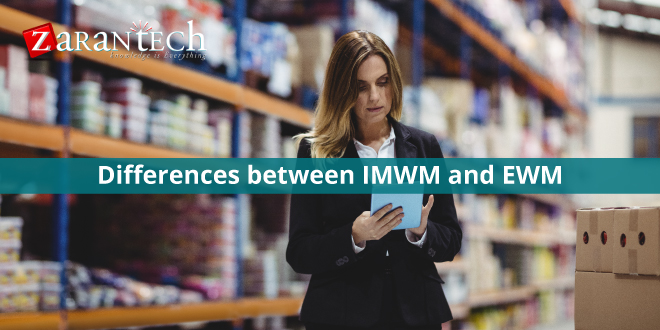Understanding the differences between the Warehouse Management System and Enterprise Resource Planning
Category: SAP EWM Posted:May 28, 2020 By: Alvera Anto
WMS vs ERP Software System
A Warehouse Management System (WMS) is primarily used to manage the storage and the movement of stock. The system tracks the motion of every stock item such as the stock obtained, picked, packed, and also shipped. The major distinction between WMS and ERP is that WMS systems provide optimization of supply on the basis of real-time info. Information can be generated to show the best location for each stock to be placed based on historical patterns and data. Additionally, WMS is normally an independent system, requiring various other components such as accounting and customer relationship management systems.
Enterprise Resource Planning (ERP) Software Program, on the other hand, automates the activities across all the departments in a company such as accountancy, customer relationship management, and also inventory management. An ERP software primarily assists in the circulation of data among all functional areas. ERP software has a lot of the capabilities of WMS software applications like tracking the program of inventory things received, packed, and shipped. The ERP software application is an incorporated all-in-one solution. It is important to keep in mind that it is non-productive to have greater than one software application running your procedures. This is because multiple applications lower effectiveness and also efficiency through duplicate entrances and rekeying errors.
Making the Choice
Not many supply chain options impact the day-to-day procedures, customer relationships, and the financial wellness of your service more than selecting and executing the ideal stock management system. The main question is whether to choose the warehouse component of your ERP System or a specialized best-of-breed WMS.
Nowadays, the differences between classic Enterprise Resource Planning and Warehouse Management System companies are blurring. Many ERP suppliers are enhancing the capacities of their system’s performance while the majority of WMS vendors are including supply chain visibility and various other administration capacities.
If Chief Finance Officers (CFOs) need to choose between a brand-new WMS and holding on to the existing ERP capability, they will certainly pick the latter. The Chief Operational Officer (COO) on the other hand, seeks systems that are adaptable, multi-functional, and risk-averse- which means selecting a best-of-breed WMS. If it is the Chief IT Officers (CIOs) making the decision, they are most interested in the existing work, the skills of their IT team, and existing hardware investments.
However, the WMS/ERP choice is a lot more challenging than who supervises the spending plan. It is a combined effort that balances the objectives of finance, IT, and operations with those of the whole organization. The selection process needs to focus on enhancing business value and delivering vital performance objectives. There are two considerations that are essential: clearly and adequately specifying the long-lasting goals of your company and functional demands, and matching the goals against the execution and the integration prices.
Many companies wrongly mean that executing a current warehousing module in their ERP system is inexpensive. Yet this is far from the fact. Just ask anyone who has actually tried to follow this process. You also can not think that the warehouse component will firmly incorporate the various other elements of your ERP system, leave alone various other details like products taking care of devices. Examine these elements: what is the expense of workarounds to compensate for absent capability? What is the likely impact on customer relations? You may realize that the totally free warehousing component that comes with your ERP is not really free after all.
Versatility
ERP systems are founded on transaction-based logic, for instance in financial and order management systems. ERP systems are best suited for the linear environment with chronological procedures and restricted exemptions. If your service is prone to consistent priority modifications, your ideal option is a WMS that is focused on real-time operations.
Capability
ERP warehouse modules conventionally require essential operational concessions in intricate procedures. Some ERP systems are also not through in-depth product management. If your operations are complicated, you might call for the boosted capability of a best-of-breed WMS.
Value
Eventually, it is the value of the system that must determine your final decision. Sticking with the module in your ERP system may be a temporary solution, but what about its worth as your business expands? It is vital to take into consideration the tough question in your return on investment (ROI) analysis: how much do you lose or gain by not spending or buying a best-of-breed WMS solution?
Organizations with a heavy supply chain component face a major dilemma. The organization has to decide between using the WMS component that comes with their ERP software program or acquire a more vivid, best-of-breed WMS bundle.
Here too, there is no ideal solution. All of it depends upon the operations of your business, your future objectives, and your financial circumstance directly. Much less noticeable but nevertheless necessary are elements such as ease of integration into various other systems, the likely impact on customer relationships, and also the price of workarounds in case the WMS does not actually have the required capability.
Bottomline
Both the ERP and the WMS systems are essential components of supply chain management created to assist organizations to handle their stock in the most effective way possible. They give information based on real-time data in a number of means and can be kept on the cloud and on a server. Each of the systems and components featured its own price, starting from a couple of thousand dollars to hundreds of thousands. Every warehouse does not require a WMS- they are complicated and also the initial and recurring prices are rather high. There are numerous levels of inventory management systems and it is essential for a company to comprehend its demands when choosing a certain system over another.
If this article has ignited a curiosity to learn more about the topic of Extended WMS, you’re in the right place. At ZaranTech, we offer a self-paced online training program on SAP EWMS conducted by some of the well-known and experienced SMEs in the industry. Feel free to browse through our course page.
Also if you’re into similar kinds of blog articles that are informative and engaging, our blog section is the ideal place for you. Happy learning!
These are the related articles that you can check



 99999999 (Toll Free)
99999999 (Toll Free)  +91 9999999
+91 9999999